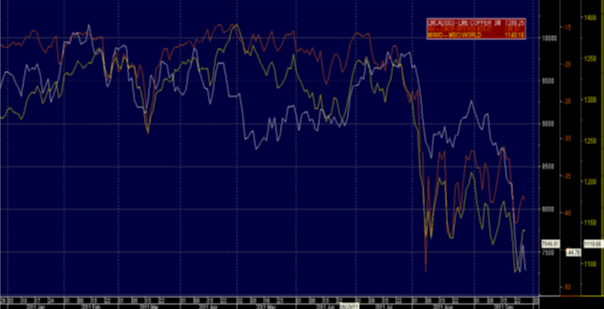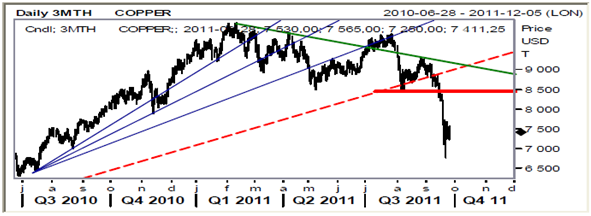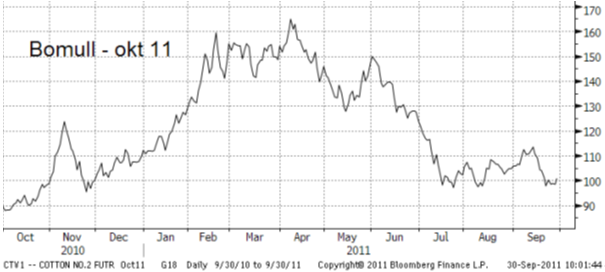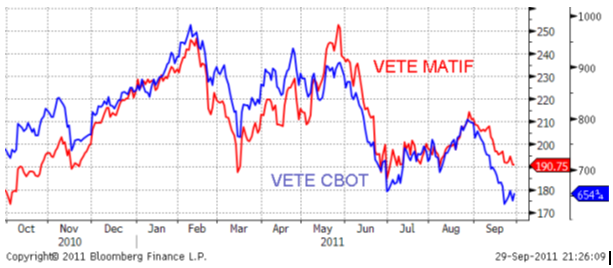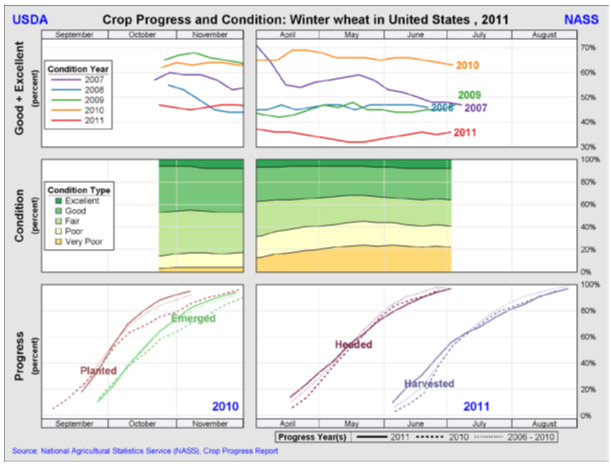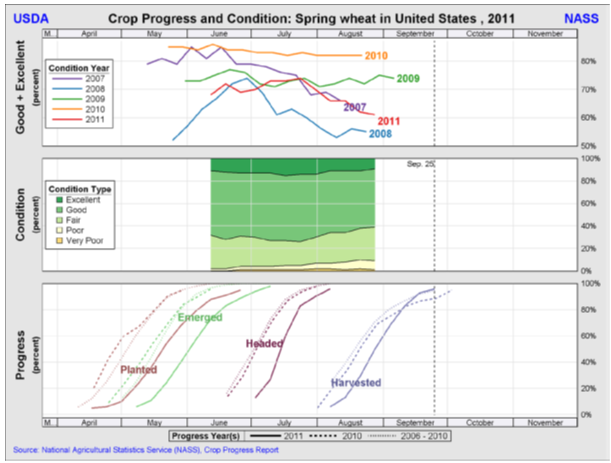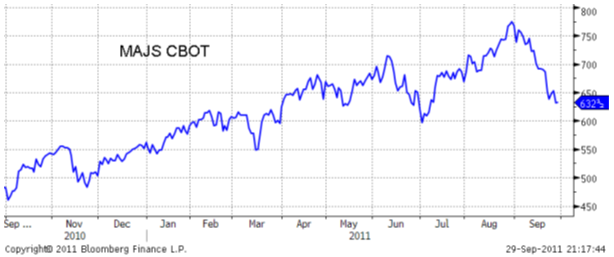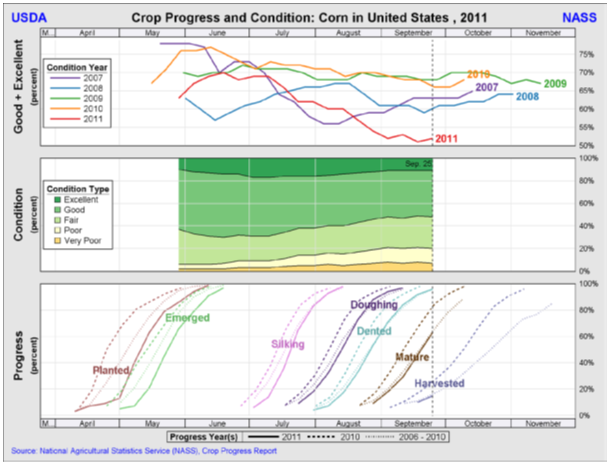Analys
SHB Råvarubrevet 30 september 2011
 Råvarorna har stabiliserats något under veckan men sentimentet har försvagats och de kraftiga rörelserna på världens börser skapar oro. Det är tydligt att investerarkollektivet skruvat ned förväntningarna, korta positioner bland icke-kommersiella aktörer har ökat samtidigt som både hedgefonder och index investerare minskat sina långa positioner. Uttalande från Fed har betonat myndighetens oförmåga att göra mycket för att stimulera den amerikanska ekonomi, man verkar lämna sitt öde till politiker. Det är inte särskilt förtroendeingivande i sig utan bidrar till den stora utförsäljningen av riskrelaterade tillgångar, såsom aktier och råvaror. Koppar är ju den typiska barometerråvaran och nedan ser ni VIX index (volatilitetsindex för S&P 500 optioner), även kallat fear index i rött, mot LME Koppar (vitt) och MSCI (gult) som ger en intressant bild över situationen.
Råvarorna har stabiliserats något under veckan men sentimentet har försvagats och de kraftiga rörelserna på världens börser skapar oro. Det är tydligt att investerarkollektivet skruvat ned förväntningarna, korta positioner bland icke-kommersiella aktörer har ökat samtidigt som både hedgefonder och index investerare minskat sina långa positioner. Uttalande från Fed har betonat myndighetens oförmåga att göra mycket för att stimulera den amerikanska ekonomi, man verkar lämna sitt öde till politiker. Det är inte särskilt förtroendeingivande i sig utan bidrar till den stora utförsäljningen av riskrelaterade tillgångar, såsom aktier och råvaror. Koppar är ju den typiska barometerråvaran och nedan ser ni VIX index (volatilitetsindex för S&P 500 optioner), även kallat fear index i rött, mot LME Koppar (vitt) och MSCI (gult) som ger en intressant bild över situationen.
När det gäller den globala ekonomin är den negativa inställningen inte bra för företagens förtroende. Vi har redan sett minskade investeringar i USA vilket även Europa lär få känna av givet nedåtrisken i den finansiella sektorn. Det verkar inte heller sannolikt att Kina kommer att ge så mycket mer fart till den globala tillverkningsindustrin så tillväxten kommer sannolikt att gå på lågväxel under de närmaste kvartalen. Förtroendet för euron är i botten och dollarn kommer fortsatt vara attraktiv som tillflyktsort till dess att marknaden ser en realistisk och trovärdig lösning på Europas skuldkris. Våra ekonomer förväntar sig därför att dollarn fortsätter att stärkas vilket kommer att verka negativt för råvarorna.
Ser man till året har vårt Råvaruindex endast tappat 2.5 procent vilket egentligen inte är så mycket jämfört med den börsutveckling vi haft. Oljan är fortfarande upp över 10 procent så det är främst metallerna som fallit, LME index har backat strax över 20 procent. Vi befinner oss i ett väldigt intressant läge och frågan är om vi nu fått den korrektionen som många väntat på och huruvida man tar tillfället i akt att komma in på lite mer fördelaktiga nivåer vad gäller säkringar och långsiktig allokering.
Handelsbankens Råvaruindex
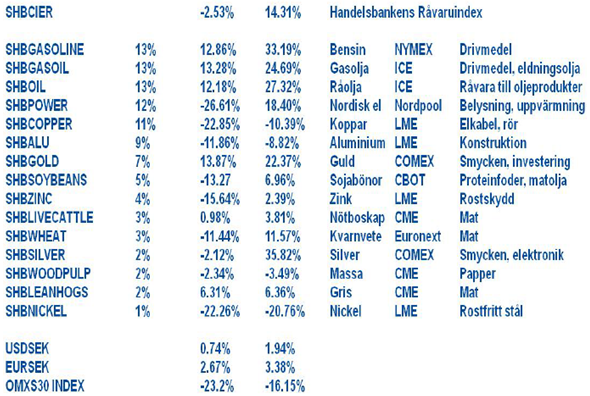
Handelsbankens råvaruindex består av de underliggande indexen för respektive råvara. Vikterna är bestämda till hälften från värdet av global produktion och till hälften från likviditeten i terminskontrakten.
Olja
Marknadsbilden fortsätter att domineras av makro sentimentet och oljepriset steg inledningsvis 3 dollar per fat på förnyat hopp om en lyckad lösning kring Greklands skuldkris.
Ett tyskt ja till att öka EFSF (European Financial Stability Facility) räckte dock ej till att hålla oljepriset uppe, fortsatt oro för den grekiska statsskulden samt dess ringverkningar fortsätter att vara huvudtemat i både råvaru- och aktiemarknaden.
Onsdagens DOE tal avslöjade en ca 2 miljoner fat ökning i de amerikanska oljelagren och fortsatt svag efterfrågan vilket i kombination med en starkare dollar har bidragit till en korrektion på ca 5 dollar per fat sedan tisdagen, i skrivande stund handlas Brent kring 103 dollar.
Framtidsbilden för Brent domineras av osäkerhet som en följd av förväntat lägre efterfrågan från OECD-länderna, i tillägg kan tillbuds sidan överraska på uppsidan då produktionen från Libyen ser ut att öka snabbare än tidigare väntat (just nu ca 250,000 fat per dag).
Ädelmetaller
Guldet gjorde en test ner mot 1535 USD per uns på måndag morgon men har sedan handlat relativt lugnt hela veckan, mellan 1600 och 1650 USD. Vi bibehåller vår försiktiga inställning och anser att man fortfarande kan avvakta med att köpa guld. Marknaden visar tecken på att ha hamnat i ett mättnadsläge, där de som behövt sälja av kortsiktigt har gjort det, men få nya köpare dyker upp.
Vi tror att lång guld fortfarande är en ganska överbefolkad position, och förra veckans börsoro gav inte den förväntade gulduppgången, varför vi tror att om riskaptiten stabiliserar sig så kan vi se guldet falla ytterligare. På längre sikt bibehåller naturligtvis guldet sin självklara plats i sparportföljen.
Koppar
Kopparpriset som förra veckan föll med närmare 12 procent har under veckan stabiliserats kring USD 7,000 dollar per ton. Nedskruvade förväntningar om efterfrågan i kombination med att marknaden bröt igenom viktiga tekniska stöd har varit starkt bidragande till den kraftiga nedgången. En stärkt dollar var också bidragande till nedgången och förväntansbilden om en ytterligare förstärkning i dollarn på 3-6 månaders sikt kommer verka negativt för sentimentet Noterade en artikel där dollarn och fundamentala förändringar tillskrevs någon femtedel (ca 125-150 dollar) vardera av rörelsen och investerare skulle stått för resten. Med det kan man säga vad man vill men det är tydligt att investerarkollektivet skruvat ned förväntningarna. Korta positioner bland icke-kommersiella aktörer har ökat samtidigt som både hedgefonder och index investerare minskat sina långa positioner. Koppar har varit den metall som ansetts vara något övervärderad i nuvarande konjunkturklimat och handlats med en alldeles för hög premie om man ser till produktionskostnaden. Det är därför inte så konstigt att man justerar ned innehavet något i takt med förändrade utsikter. På lång sikt tror jag de flesta är övertygade om att vi går mot en väldigt stram balans till följd av vikande halter och eskalerande kostnader, vilket gör att man kommer sitta kvar på långa positioner och ta tillfället i akt att köpa på sig metaller och Koppar i synnerhet vid just sådana här nedställ.
Marknaden har brutit igenom ett flertal intressanta tekniska nivåer och ser nu ut att finna stöd. Vi förväntar oss således att marknaden får en rekyl efter det kraftiga nedstället och successivt återhämtar sig till strax över 8,000 dollar för att sedan handlas sidledes under resten av året.
El
Kontraktet Q1 2011 har fallit med 4.5 procent under veckan efter fortsatt god nederbörd och låga spotpriser. Energibalansen har förbättrats rejält under sommaren och vi ligger nu på ett överskott mot normalen om 4,6 TWh (3,6 TWh i söndags). Vi räknar ligga runt 3,5 TWh i överskott i slutet av veckan och kring 3,8 TWh i slutet av vecka 40. Vi har dragits med ett underskott i närmare 2 år och i vintras var det hela 40 TWh som mest!. Svensk Kärnkraft är osäker inför vintern vilket bidrar ngt till riskpremien på marknaden. För närvarande är bara 41 procent av den svenska kärnkraftskapaciteten i drift. Sprinklerproblem vid 2 av Ringhals reaktorer och risk för ytterligare problem genererar en viss oro. Myndigheterna har som ett resultat av detta höjt säkerhetskraven och ökat kontrollerna vid samtliga svenska reaktorer.
Fossila bränslen ger också ett visst fortsatt stöd och energikolet handlas exempelvis ca 20 procent högre än vid samma tid förra året. Brytpriset (teoretiskt break-even) för att köra kol nu ca 48 EUR/MWh och ner mot 47 EUR/MWh lite längre ut på kurvan. Utsläppsrätterna fortsätter ned och handlas 35 procent lägre nu än för ett år sedan då flertalet kapitaliserat på sitt överskott, det ger ca 3.5 öre rabatt på elpriset.
Spotpriset i Sverige har hittills i år varit ca 47 öre per kWh (52 öre per kWh för samma period förra året). Spotpriset har kommit in extremt lågtt och legat under 30 euro / MWh de senaste 2 veckorna. Spotpriset för imorgon lördag är så lågt som 6.27 euro för systempris (snitt i Norden) och 9.14 euro för Sverige då vattenproducenter tvingats köra väldigt mycket vatten. Så länge vi får mycket vatten och spotpriserna är låga finns det ingen anledning till att köpa el just nu utan vi förväntar oss att marknaden fortsätter ned.
Bomull
Vi har sett bomullspriserna falla markant från vårens rekordhöga nivåer, detta till följd av minskad global efterfrågan och minskad handel.
I början av september sänkte ICAC (International Cotton Advisory Commitee) sin prognos på världskonsumtionen av bomull och sedan dess har vi sett bomullspriset falla ca 10 % . Vi har även kunnat ta del av data som påvisar att Indiens export av bomull kan komma att bli betydligt högre än beräknat tack vare mindre restriktiva handelshinder. Indien vill undvika att få sitta med stora volymer av eget lager som tidigare år. Indien går mot ett år av rekordskörd efter årets första halvår, detta p.g.a. bättre förhållanden för plantornas utveckling med gynnsam nederbörd.
Det som talar för en stabilisering av bomullspriset är att prognoserna av den totala lagernivån vid årets slut är relativt låga och trots prognoser på rekordhög skörd i år samt att förhållandet mellan utgående lager och årlig konsumtion är 45 % (mot förra årets 38 %) så är fortfarande siffran den lägsta sedan 1995. Dessutom har Pakistan som är fjärde rankade land av bomullsproduktion förlorat en stor del av sina plantor den senaste månaden i översvämningar, samt att orkanen Irene orsakade mer förstörelser än man trott på bomullsplantagerna i USA.
Vete
Vetepriserna i Chicago har återhämtat sig något efter förra veckans kraftiga nedgång, Matifvetet har däremot fortsatt något nedåt. Inga större fundamentala nyheter har nått marknaden, som varit något avvaktande inför dagens rapport från USDA. Den senaste tidens nedgång har ökat efterfrågan något, men samtidigt har även de ryska priserna backat, vilket ger fortsatt press nedåt på amerikanska och europeiska priser.
Vädret är fortsatt torrt i stora delar av USA, vilket gynnar den återstående skörden av vårvete – men höstvetesådden är i fortsatt stort behov av mer regn.
Den ryska veteskörden är till 86 procent avklarad, och volymen uppskattas hittills till 53,5 miljoner ton. Mindre skurar fördröjer det återstående skördearbetet något, men regnet är samtidigt gynnsamt för kommande sådd. Även Ukraina har fått en del regn men mer behövs för sådden. Veteexporten från Ryssland beräknas än så länge ha nått uppemot 3 miljoner ton för säsongen, något under förväntan men fortfarande rekord. Problem kan komma senare i december med logistik, beroende på vädret och ett behov av att få tag i spannmål inte bara från landets södra delar. Ryssland och Kazakstan sålde igår, som väntat, totalt 240.000 ton vete till Egypten, med priser klart lägre än konkurrenternas.
I Kanada har vädret varit gynnsamt för den pågående skörden, och väntas bli så ett tag framöver. Argentina har varit torrt men har fått en del välbehövlig nederbörd, men mer behövs. I Australien uppges vädret vara fördelaktigt.
Inga större förändringar i dagens rapport från USDA. Förmodligen kommer siffrorna för den amerikanska vårveteproduktionen justeras ned, sedan skörderapporter pekat på lägre produktion än väntat. Dessutom väntas konsumtionen av vete i USA justeras upp som följd av ökad efterfrågan på grund av höga priser på majs. Lager av vete den 1 september i USA uppskattas av marknaden i genomsnitt till 2 044 miljoner bushels, med ett intervall om 2 003-2 084 miljoner bushels.
Enligt måndagens rapport från USDA var den amerikanska höstvetesådden fortsatt försenad som följd av torrt väder. 26 procent av den beräknade arealen uppgavs vara sådd, upp från förra veckans 14 procent. Vid samma tid förra året var motsvarande siffra 32 procent och genomsnittet för de senaste fem åren är än högre med 35 procent.
6 procent av grödan uppgavs ha nått uppkomststadiet, att jämföra med 10 procent vid samma tid förra året och 10 procent även för genomsnittet för de senaste fem åren.
Den amerikanska skörden av vårvete uppgavs vara till 96 procent avklarad, upp från förra veckans 93 procent. Vid samma tid förra året var 89 procent av skörden klar och genomsnittet för de senaste fem åren är 95 procent.
Majs
Terminspriserna på majs i Chicago har fortsatt nedåt, som för övriga råvaror påverkat av en ökad oro för den globala ekonomin och brist på viktiga fundamentala nyheter. Majsen har backat omkring 18 procent i pris sedan slutet av augusti månad, vilket i samband med gällande lagernivåer kan tyckas vara något överdrivet. Skörderapporter pekar dessutom på något lägre avkastningsnivå än väntat.
Efterfrågan i USA har ökat något som följd av prisnedgången, men utländska köpare ser fortfarande bättre priser på dels majs av annat ursprung men också fodervete. Spekulationer pågår fortfarande om Kinas eventuella köp av stora volymer majs från USA eller Argentina – vilket ännu ej bekräftats.
Torrt väder är gynnsamt för den amerikanska skörden, vilken ligger något efter tidsmässigt jämfört med normalt. Mer regn behövs i Argentina för att gynna den kommande sådden.
Blickarna har de senaste dagarna även riktats mot dagens rapport från USDA, i vilken uppskattning om lagernivåer den 1 september presenteras. Viss oro finns att USDA uppskattar majslagret till något högre nivå än väntat, vilket skulle vara en följd av den ökade användningen av fodervete som följd av höga majspriser. Samtidigt borde det vara svårt att överraska marknaden tillräckligt för att kunna pressa ned priserna i högre grad utifrån den senaste tidens kraftiga nedgång.
Den genomsnittliga marknadsuppfattningen tyder på en lagernivå den 1 september på 964 miljoner bushels, med ett intervall på 835-1 050 miljoner bushels. Vid samma tid förra året uppgick lagernivån till 1 708 miljoner bushels.
Den amerikanska majsskörden är något försenad och i måndagens rapport uppgavs 15 procent av grödan vara skördad, upp från förra veckans 10 procent. Vid samma tid förra året var 26 procent av skörden avklarad och genomsnittet för de senaste fem åren är 16 procent.
63 procent av grödan uppgavs vara mogen för skörd, jämfört med 46 procent förra veckan. Klart efter förra årets 83 procent vid samma tidpunkt och även efter genomsnittet för de senaste fem åren om 64 procent.
Andelen av grödan som uppgavs vara i skicket ”good/excellent” var 52 procent, upp en procentenhet från föregående vecka. Klart sämre än 66 procent förra året.
Samtidigt minskade andelen av grödan som bedöms vara i skicket ”poor/very poor” med en procentenhet till 20 procent, fortfarande klart över förra årets 13 procent.
[box]SHB Råvarubrevet är producerat av Handelsbanken och publiceras i samarbete och med tillstånd på Råvarumarknaden.se[/box]
Ansvarsbegränsning
Detta material är producerat av Svenska Handelsbanken AB (publ) i fortsättningen kallad Handelsbanken. De som arbetar med innehållet är inte analytiker och materialet är inte oberoende investeringsanalys. Innehållet är uteslutande avsett för kunder i Sverige. Syftet är att ge en allmän information till Handelsbankens kunder och utgör inte ett personligt investeringsråd eller en personlig rekommendation. Informationen ska inte ensamt utgöra underlag för investeringsbeslut. Kunder bör inhämta råd från sina rådgivare och basera sina investeringsbeslut utifrån egen erfarenhet.
Informationen i materialet kan ändras och också avvika från de åsikter som uttrycks i oberoende investeringsanalyser från Handelsbanken. Informationen grundar sig på allmänt tillgänglig information och är hämtad från källor som bedöms som tillförlitliga, men riktigheten kan inte garanteras och informationen kan vara ofullständig eller nedkortad. Ingen del av förslaget får reproduceras eller distribueras till någon annan person utan att Handelsbanken dessförinnan lämnat sitt skriftliga medgivande. Handelsbanken ansvarar inte för att materialet används på ett sätt som strider mot förbudet mot vidarebefordran eller offentliggörs i strid med bankens regler.
Finansiellt instruments historiska avkastning är inte en garanti för framtida avkastning. Värdet på finansiella instrument kan både öka och minska och det är inte säkert att du får tillbaka hela det investerade kapitalet.
Analys
Tightening fundamentals – bullish inventories from DOE

The latest weekly report from the US DOE showed a substantial drawdown across key petroleum categories, adding more upside potential to the fundamental picture.

Commercial crude inventories (excl. SPR) fell by 5.8 million barrels, bringing total inventories down to 415.1 million barrels. Now sitting 11% below the five-year seasonal norm and placed in the lowest 2015-2022 range (see picture below).
Product inventories also tightened further last week. Gasoline inventories declined by 2.1 million barrels, with reductions seen in both finished gasoline and blending components. Current gasoline levels are about 3% below the five-year average for this time of year.
Among products, the most notable move came in diesel, where inventories dropped by almost 4.1 million barrels, deepening the deficit to around 20% below seasonal norms – continuing to underscore the persistent supply tightness in diesel markets.
The only area of inventory growth was in propane/propylene, which posted a significant 5.1-million-barrel build and now stands 9% above the five-year average.
Total commercial petroleum inventories (crude plus refined products) declined by 4.2 million barrels on the week, reinforcing the overall tightening of US crude and products.


Analys
Bombs to ”ceasefire” in hours – Brent below $70

A classic case of “buy the rumor, sell the news” played out in oil markets, as Brent crude has dropped sharply – down nearly USD 10 per barrel since yesterday evening – following Iran’s retaliatory strike on a U.S. air base in Qatar. The immediate reaction was: “That was it?” The strike followed a carefully calibrated, non-escalatory playbook, avoiding direct threats to energy infrastructure or disruption of shipping through the Strait of Hormuz – thus calming worst-case fears.

After Monday morning’s sharp spike to USD 81.4 per barrel, triggered by the U.S. bombing of Iranian nuclear facilities, oil prices drifted sideways in anticipation of a potential Iranian response. That response came with advance warning and caused limited physical damage. Early this morning, both the U.S. President and Iranian state media announced a ceasefire, effectively placing a lid on the immediate conflict risk – at least for now.
As a result, Brent crude has now fallen by a total of USD 12 from Monday’s peak, currently trading around USD 69 per barrel.
Looking beyond geopolitics, the market will now shift its focus to the upcoming OPEC+ meeting in early July. Saudi Arabia’s decision to increase output earlier this year – despite falling prices – has drawn renewed attention considering recent developments. Some suggest this was a response to U.S. pressure to offset potential Iranian supply losses.
However, consensus is that the move was driven more by internal OPEC+ dynamics. After years of curbing production to support prices, Riyadh had grown frustrated with quota-busting by several members (notably Kazakhstan). With Saudi Arabia cutting up to 2 million barrels per day – roughly 2% of global supply – returns were diminishing, and the risk of losing market share was rising. The production increase is widely seen as an effort to reassert leadership and restore discipline within the group.
That said, the FT recently stated that, the Saudis remain wary of past missteps. In 2018, Riyadh ramped up output at Trump’s request ahead of Iran sanctions, only to see prices collapse when the U.S. granted broad waivers – triggering oversupply. Officials have reportedly made it clear they don’t intend to repeat that mistake.
The recent visit by President Trump to Saudi Arabia, which included agreements on AI, defense, and nuclear cooperation, suggests a broader strategic alignment. This has fueled speculation about a quiet “pump-for-politics” deal behind recent production moves.
Looking ahead, oil prices have now retraced the entire rally sparked by the June 13 Israel–Iran escalation. This retreat provides more political and policy space for both the U.S. and Saudi Arabia. Specifically, it makes it easier for Riyadh to scale back its three recent production hikes of 411,000 barrels each, potentially returning to more moderate increases of 137,000 barrels for August and September.
In short: with no major loss of Iranian supply to the market, OPEC+ – led by Saudi Arabia – no longer needs to compensate for a disruption that hasn’t materialized, especially not to please the U.S. at the cost of its own market strategy. As the Saudis themselves have signaled, they are unlikely to repeat previous mistakes.
Conclusion: With Brent now in the high USD 60s, buying oil looks fundamentally justified. The geopolitical premium has deflated, but tensions between Israel and Iran remain unresolved – and the risk of missteps and renewed escalation still lingers. In fact, even this morning, reports have emerged of renewed missile fire despite the declared “truce.” The path forward may be calmer – but it is far from stable.
Analys
A muted price reaction. Market looks relaxed, but it is still on edge waiting for what Iran will do

Brent crossed the 80-line this morning but quickly fell back assigning limited probability for Iran choosing to close the Strait of Hormuz. Brent traded in a range of USD 70.56 – 79.04/b last week as the market fluctuated between ”Iran wants a deal” and ”US is about to attack Iran”. At the end of the week though, Donald Trump managed to convince markets (and probably also Iran) that he would make a decision within two weeks. I.e. no imminent attack. Previously when when he has talked about ”making a decision within two weeks” he has often ended up doing nothing in the end. The oil market relaxed as a result and the week ended at USD 77.01/b which is just USD 6/b above the year to date average of USD 71/b.

Brent jumped to USD 81.4/b this morning, the highest since mid-January, but then quickly fell back to a current price of USD 78.2/b which is only up 1.5% versus the close on Friday. As such the market is pricing a fairly low probability that Iran will actually close the Strait of Hormuz. Probably because it will hurt Iranian oil exports as well as the global oil market.
It was however all smoke and mirrors. Deception. The US attacked Iran on Saturday. The attack involved 125 warplanes, submarines and surface warships and 14 bunker buster bombs were dropped on Iranian nuclear sites including Fordow, Natanz and Isfahan. In response the Iranian Parliament voted in support of closing the Strait of Hormuz where some 17 mb of crude and products is transported to the global market every day plus significant volumes of LNG. This is however merely an advise to the Supreme leader Ayatollah Ali Khamenei and the Supreme National Security Council which sits with the final and actual decision.
No supply of oil is lost yet. It is about the risk of Iran closing the Strait of Hormuz or not. So far not a single drop of oil supply has been lost to the global market. The price at the moment is all about the assessed risk of loss of supply. Will Iran choose to choke of the Strait of Hormuz or not? That is the big question. It would be painful for US consumers, for Donald Trump’s voter base, for the global economy but also for Iran and its population which relies on oil exports and income from selling oil out of that Strait as well. As such it is not a no-brainer choice for Iran to close the Strait for oil exports. And looking at the il price this morning it is clear that the oil market doesn’t assign a very high probability of it happening. It is however probably well within the capability of Iran to close the Strait off with rockets, mines, air-drones and possibly sea-drones. Just look at how Ukraine has been able to control and damage the Russian Black Sea fleet.
What to do about the highly enriched uranium which has gone missing? While the US and Israel can celebrate their destruction of Iranian nuclear facilities they are also scratching their heads over what to do with the lost Iranian nuclear material. Iran had 408 kg of highly enriched uranium (IAEA). Almost weapons grade. Enough for some 10 nuclear warheads. It seems to have been transported out of Fordow before the attack this weekend.
The market is still on edge. USD 80-something/b seems sensible while we wait. The oil market reaction to this weekend’s events is very muted so far. The market is still on edge awaiting what Iran will do. Because Iran will do something. But what and when? An oil price of 80-something seems like a sensible level until something do happen.
-

 Nyheter4 veckor sedan
Nyheter4 veckor sedanUppgången i oljepriset planade ut under helgen
-

 Nyheter3 veckor sedan
Nyheter3 veckor sedanMahvie Minerals växlar spår – satsar fullt ut på guld
-

 Nyheter4 veckor sedan
Nyheter4 veckor sedanLåga elpriser i sommar – men mellersta Sverige får en ökning
-

 Nyheter2 veckor sedan
Nyheter2 veckor sedanOljan, guldet och marknadens oroande tystnad
-

 Nyheter2 veckor sedan
Nyheter2 veckor sedanJonas Lindvall är tillbaka med ett nytt oljebolag, Perthro, som ska börsnoteras
-

 Analys4 veckor sedan
Analys4 veckor sedanVery relaxed at USD 75/b. Risk barometer will likely fluctuate to higher levels with Brent into the 80ies or higher coming 2-3 weeks
-

 Analys3 veckor sedan
Analys3 veckor sedanA muted price reaction. Market looks relaxed, but it is still on edge waiting for what Iran will do
-

 Nyheter2 veckor sedan
Nyheter2 veckor sedanDomstolen ger klartecken till Lappland Guldprospektering


